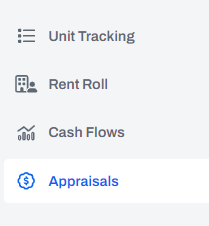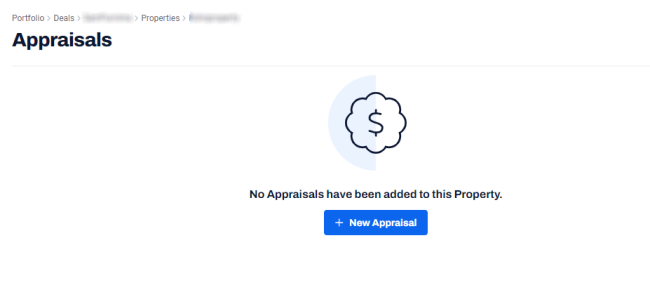Creating an appraisal
You can create an appraisal for property and units.
Note: Ensure that:
• A deal is created.
• Full access is provided to the following Asset Management permissions:
• Property Tracking
• Units
• Appraisals
• A property is added to a deal.
• In order to apply an Appraisal to a unit, at least one unit is added within a property.
• In order to assign a Real estate appraiser to the Appraisal, the Real Estate Appraisers are added to the Organization Contacts (External).
To create an appraisal for a property or unit, perform the following steps.
| 1. | At the top-left of the page, click Portfolio. |

| 2. | On the Portfolio page, click Deal ID or View for the deal that you want to update. |

| 3. | On the left navigation menu, click Property. |

| 4. | On the Property page, click View for the property that you want. |

| 5. | In the left navigation menu, click Appraisals. |

| 6. | On the Appraisals page, click New Appraisal. |

| 7. | In the New Appraisal dialog box, enter the following information. |

| Field | Description | |||||||||
|---|---|---|---|---|---|---|---|---|---|---|
| Appraisal Details | ||||||||||
| Appraisal Type |
The appraisal type such as Commercial, Lot, and Plan.
This field is mandatory. |
|||||||||
| Unit |
The unit(s) for which you want to create an appraisal. |
|||||||||
| Appraisal Date |
The date when the appraiser assesses the property and determines its value. This field is mandatory. |
|||||||||
| Appraisal Expiration Date | The appraisal expiration date. | |||||||||
| Appraised As Of Date | The specific date from when the appraisal becomes effective. | |||||||||
| Appraised By | The appraiser who evaluated the property. | |||||||||
| Appraisal Sq Footage | The square footage of the property. | |||||||||
|
Appraisal Unit Count |
The number of units within a property. |
|||||||||
|
Appraisal Name |
The name of the appraisal. |
|||||||||
|
Final Reconciled Market Values |
||||||||||
|
Final Appraised Value |
The final appraised value of a property. This field is mandatory. |
|||||||||
|
As Is Value |
The value of a property in its current physical condition, without any repairs, renovations, or improvements. |
|||||||||
|
As Complete Value |
The value of a property after it is fully constructed. |
|||||||||
|
As Stabilized Value |
The value of a property after occupancy, income generation, improvements, renovations, or lease-up. |
|||||||||
|
Upon Completion Value |
The value of a property after it is fully constructed and it is ready for occupancy. |
|||||||||
|
Upon Stabilized Value |
The value of a property after it reaches a stable state of occupancy and generates consistent income. |
|||||||||
|
Go Dark Value |
The value of a property if the primary tenant were to vacate the property. This value is crucial when there is a single tenant in the property. |
|||||||||
|
Insurable Value |
The insurable value is the cost required to fully replace or rebuild a property if it were to be damaged or destroyed. |
|||||||||
|
Appraisal Valuation Approach |
The approach used to determine the value of a property through an appraisal process. You can determine the value of a property using either of the following approaches:
To add an Appraisal Valuation Approach:
Note: According to the selected approach, the Cost/Sq Ft, Capitalization Rate, or Price/Sq Ft field is displayed.
Note: • To edit an approach, click Edit • To delete an approach, click Delete |
|||||||||
|
Valuation Methodology Details |
||||||||||
|
Anticipated Stabilized Date |
The projected date when the property is expected to achieve stabilization. At this stage, necessary construction, repairs, and renovations are complete, and the property is fully operational. |
|||||||||
|
Discount Rate |
The interest rate used to calculate the Net Present Value (NPV) of expected cash flows. |
|||||||||
|
Absorption Rate |
The rate at which available space is leased or sold within a specific period. It is a key metric for understanding the demand for properties. |
|||||||||
|
Absorption Rate Frequency |
The period for which absorption rate is calculated, such as Monthly, Quarterly, and Yearly. |
|||||||||
|
Land Value |
The value of a property including land and any improvements (such as buildings or landscaping). |
|||||||||
|
Site Value |
The value of the land excluding any improvements that alters its value. |
|||||||||
|
Improvement Value |
The value of improvements made to a property. |
|||||||||
|
Replacement Value |
The amount required to repair or reconstruct the property to its original state after a loss ( For example, fire or damage). |
|||||||||
|
Interest Appraised |
The interest appraised such as Fee Simple, Leasehold, and Fee and Leasehold. |
|||||||||
| 4. | Click + New Appraisal. |
A message is displayed indicating that the appraisal is created successfully.
 .
. .
.